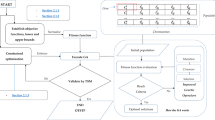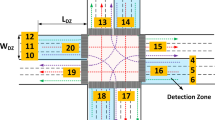Abstract
Traffic waves occur when the density of vehicles exceeds a critical threshold, and traffic management draws more and more attention due to the increasing need to alleviate traffic congestion in metropolises. In the present study, energy–energy flux models were introduced into the modeling of start and stop waves of vehicles, based on analysis of characteristics of traffic waves. An indicator system was established to evaluate the service quality of single-signalized intersections. The results showed that under given time costs the service quality was negatively correlated to the energy and the absolute value of energy flux of the stop wave, which highlights the need to optimize the time cost. To this end, we built a stop-wave time cost model on the basis of the energy–energy flux models and simulation data. The model was then optimized by the formulation of a multi-objective optimization problem that can be solved by adjusting the parameters of the \(fgoalattain\) function in Matlab. It was found that under certain constraints, the optimal service quality was achieved when the traffic signal cycle length was 150 s and green/cycle ratio was 0.5; with the aid of optimization, the average energy density of the stop wave reduced by 37.10%, while the energy flux density increased by 1.50%. Additionally, the \(Elman\) algorithm was employed to forecast the energy and energy flux of the stop wave, the forecast error of which was controlled within 5% under the optimal time cost. A visualization window to monitor the single-signalized intersection was produced to improve the service quality. It is therefore expected that main findings from current study may contribute to promoting construction of intelligent traffic management systems.








Similar content being viewed by others
Data Availability
All data generated or analyzed during this study are included in this article.
Abbreviations
- \({u}_{w}\) :
-
Traffic wavfront velocity wavefront
- \({k}_{i}\) :
-
Traffic density, \(i=\text{1,2}\)
- \({k}_{j}\) :
-
The jammed traffic density
- \({u}_{i}\) :
-
Traffic average speed, \(i=\text{1,2}\)
- \({q}_{i}\) :
-
Traffic flow rate, \(i=\text{1,2}\)
- \({\eta }_{i}\) :
-
Standard traffic density for neighboring zone, \(i=\text{1,2}\)
- \(c\) :
-
Traffic signal cycle
- r:
-
Red traffic signal interval
- g:
-
Green traffic signal interval
- \(dm\) :
-
Volume element
- \(dV\) :
-
Speed element
- \(m\) :
-
The mass
- \(v\) :
-
The vibration velocity
- \(\rho\) :
-
The density
- \(V\) :
-
The volume
- \(f\) :
-
Frequency
- \(T\) :
-
Cycle
- \(k\) :
-
Restoring force coefficient of the oscillation system
- \(A\) :
-
Amplitude
- \(\omega\) :
-
Angular frequency or the circular frequency
References
Shi, J., Kong L. J., Liu M. R. (2002). Traffic waves under control of red and green lights. Journal of Guangxi Normal University (Natural Science Edition), 20 (3), 1–4
Honda, Y., & Horiguchi, T. (2001). Self-organization in four-direction traffic-flow model. Journal of the Physical Society of Japan, 69(11), 3744–3751.
Huang, P. H., Kong, L. J., & Liu, M. R. (2001). A study on the two-dimensional main-road CA traffic flow model. Journal of Guangxi Normal University, 19(2), 8–12.
Shi, W., Liu, X. M., & Lu, S. F. (2011). A Method for calculation of traffic wave propagation velocity. Chinese Journal of Theoretical and Applied Mechanics, 43(5), 850–855.
Van Lint, H. (2002). The physics of traffic jam. Reports on Progress in Physics, 65(9), 1331–1386.
Li, P. F., Liu, X. M., & Shi, J. J. (2014). Traffic wave models under different traffic states. Journal of Beijing University of Technology, 40(11), 1680–1686.
Wang, H. W., Cheng, K., Lu, Q. C., & Peng, Z. R. (2016). Improved model of start-wave velocity at intersections based on unmanned aerial vehicle data. Journal of Donghua University (English Edition), 33(1), 13–19.
Horn, B. K. P., & Wang, L. (2018). Wave equation of suppressed traffic flow instabilities. IEEE Transactions on Intelligent Transportation Systems, 19(9), 2955–2964.
Sun, D., Chen, D., Zhao, M., Liu, W., & Zheng, L. (2018). Linear stability and nonlinear analyses of traffic waves for the general nonlinear car-following model with multi-time delays. Physica A Statistical Mechanics & Its Applications, 501, 293–307.
Wang, Y. Q., Zhou, C. F., Li, W. K., Yan, B. W., Jia, B. & Wang, J. X. (2018). Stability analysis and wave dynamics of an extended hybrid traffic flow model. Modern Physics Letters B, 32(5), 1850055-1-19.
Khan, M., Ectors, W., Bellemans, T., Janssens, D., & Wets, G. (2018). Unmanned aerial vehicle-based traffic analysis: A case study for shockwave identification and flow parameters estimation at signaled intersections. Remote Sensing, 10(3), 458.
Wang, D. H., Jing, C. G., & Qu, Z. W. (2002). Application of traffic wave theory in analysis of traffic flow at intersections. China Journal of Highway and Transport, 15(1), 93–96.
Sun, H., & Liu, L. (2010). Control of minimum signal cycles at intersections based on the traffic wave theory. Technology & Economy in Areas of Communications, 5, 19–21.
Wang, H. X., & Qi, C. H. (2010). Analysis of traffic waves of vehicle flows at signaled intersections in Hohhot. Journal of Inner Mongolia Agricultural University, 31(4), 182–184.
Guan, Z., & Wei, L. Y. (2010). Research on Queuing of vehicles under the impact of buses based on the traffic wave theory. Journal of Transportation Systems Engineering and Information Technology, 10(5), 161–166.
Ma, J. P. (2011). Analysis of traffic waves in accidents. Transpoworld, 20, 98–100.
Kim, J. (2016). Modeling vehicular traffic shock wave with machine learning approaches. UCLA, Los Angeles, California, America.
Han, Z., Wang, Z. & Yue, H. (2017). Study on traffic congestion pre-control of link between non-signalized intersections. International Conference on Intelligent Computation Technology and Automation. IEEE Computer Society, pp 378–381.
Wu, D., Zhao, J., & Yang, X. (2009). Impact of bus stop on signalized intersection capacity. In Second International Conference on Intelligent Computation Technology and Automation. IEEE Computer Society, pp 619–624.
Chen, Y. H., et al. (2014). Modelling of interference of vans on passenger cars on uphill slopes based on the mobile bottleneck traffic wave theory. Journal of Jilin University (Engineering Edition), 44(5), 1290–1295.
Song, B. W., Zhang, J. Y., Li, Q. Y., & Liu, Q. (2014). Improving the dynamic road impedance function based on the traffic wave theory. Journal of Chongqing Jiaotong University (Natural Science Edition), 33(1), 106–110.
Li S., Song Z. Y. (2004). Research on the dynamic macroscopic road section travel-time model. Journal of Wuhan University of Technology, 28 (6), 24–29.
Xiang, H. K. (2016). Road impedance function model based on the traffic wave theory. Journal of Shenzhen Polytechnic, 15(1), 9–14.
Xiang, H. (2016). Road impedance model study based on traffic wave theory. Journal of Shenzhen Polytechnic, 15(1), 9–13.
Julio, N., Giesen, R., & Lizana, P. (2016). Real-time prediction of bus travel speeds using traffic shockwaves and machine learning algorithms. Research in Transportation Economics, 59, 250–270.
Chou, L. D., Shen, T. Y., Tseng, C. W., Chang, Y. J., & Kuo, Y. W. (2016). Green wave-based virtual traffic light management scheme with vanets[J]. International Journal of Ad Hoc & Ubiquitous Computing, 24(1/2), 22–32.
Qu, D. Y., et al. (2016). Arterial road green wave coordination and control method based on the traffic wave theory. Journal of Highway and Transportation Research and Development, 33(9), 112–119.
Qu, D. Y., et al. (2017). Artery phase difference optimization and control based on the traffic wave theory. Journal of Jilin University (Engineering Edition), 47(2), 429–437.
Carey, M., & Mccartney, M. (2002). Behaviour of a whole-link travel time model used in dynamic traffic assignment. Transportation Research Part B, 36(1), 83–95.
Laval, J. A. (2004). Hybrid models of traffic flow: Impacts of bounded vehicle accelerations. University of California.
Jin, J., Qiu, Z., & Ran, B. (2006). Intelligent route-based speed estimation using timing advance. IEEE Intelligent Transportation Systems Conference. IEEE, pp 194–197.
Gao, Z. G., Liu, H. Z., & Zhou, T. (2009). Applied analysis of the traffic wave theory in traffic bottlenecks. Transport Standardization, 11, 77–80.
Zhao, Q., Kong, Q. J., Xia, Y., & Liu, Y. (2011). Sample size analysis of GPS probe vehicles for urban traffic state estimation. International IEEE Conference on Intelligent Transportation Systems. IEEE, pp. 272–276.
Fiengo, G., Petrillo, A., Salvi, A., Santini, S. & Tufo, M. (2016). A control strategy for reducing traffic waves in delayed vehicular networks. Decision and Control. IEEE, pp 2462–2467.
Telesca, L., & Lovallo, M. (2008). Analysis of the temporal properties in car accident time series. Physica A Statistical Mechanics & Its Applications, 387(13), 3299–3304.
Baykal-Gürsoy, M., Xiao, W., & Ozbay, K. (2009). Modeling traffic flow interrupted by incidents. European Journal of Operational Research, 195(1), 127–138.
Zhao, S. G. (2009). Research on the impact of traffic accident sites on the traffic waves. Acta Physica Sinica, 58(11), 7497–7501.
Gao, F. D. (2017). Research on the impact of traffic accidents on continuous traffic flow based on the traffic wave theory. Engineering Technology, 44(12), 51–53.
Cui, M., Xue, H. F., Chen, F. Z., Fan-Biao, B. U., & Automation, S. O. (2018). Simulation of traffic congestion prediction for pedestrian crossing road. Computer Simulation, 2, 81–84.
He, Y. Q., Rong, Y. L., & Liu, Z. P. (2018). Analysis of the impact of road traffic accidents based on the water wave theory. Urban Transport of China, 16(3), 39–45.
Yao, J., Li, F., & Tang, K., et al. (2019). Sampled trajectory data-driven method of cycle-based volume estimation for signalized intersections by hybridizing shockwave theory and probability distribution. IEEE Transactions on Intelligent Transportation Systems, (99), pp 1–13.
Stephanopoulos, G., Michalopoulos, P. G., & Stephanopoulos, G. (1979). Modelling and analysis of traffic queue dynamics at signaled intersections. Transportation Research Part A General, 13(5), 295–307.
Zhang, Z. Y., Huang, Y., & Ren, F. T. (2009). Research on the response time of the following car under the decelerated car-following status. Journal of Beijing University of Technology, 35(9), 1220–1224.
Yang, L., Zhong, Q., & Cheng, M.Z. (2021). Optimal design of transportation signal control at the intersection based on Webster signal timing metho. Journal of Physics: Conference Series, 1972(1),012130 (6pp).
Sun, D. J., Wu, S., Shen, S., et al. (2021). Simulation and assessment of traffic pollutant dispersion at an urban signalized intersection using multiple platforms. Atmospheric Pollution Research, 12(2), 101087.
Zhang, H., et al. (2012). New technology for acquisition and analysis of dynamic traffic data. China Communications Press.
Author information
Authors and Affiliations
Contributions
All authors make equal contributions to this paper.
Corresponding author
Additional information
Publisher's Note
Springer Nature remains neutral with regard to jurisdictional claims in published maps and institutional affiliations.
Rights and permissions
About this article
Cite this article
Su, Zy., Wu, Jm. Time Cost Optimization at Single-Signalized Intersections Based on the Energy–Energy Flux Model. Wireless Pers Commun 126, 3515–3541 (2022). https://doi.org/10.1007/s11277-022-09877-7
Accepted:
Published:
Issue Date:
DOI: https://doi.org/10.1007/s11277-022-09877-7




